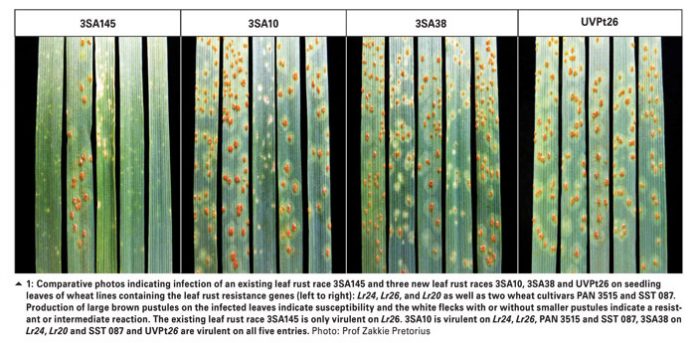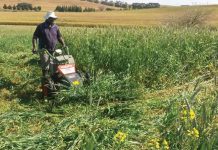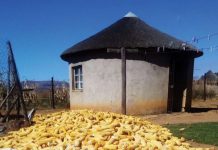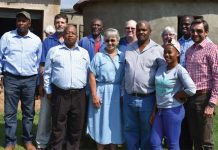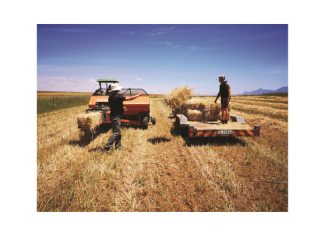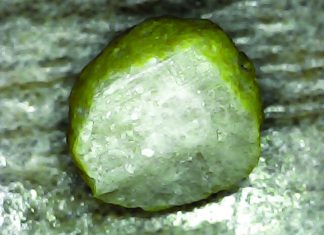September 2017
Drs Tarekegn Terefe, ARC-Small Grain, Bethlehem, Willem Boshoff and Prof Zakkie Pretorius, University of the Free State
Leaf rust, stem rust and stripe rust are important fungal diseases of wheat in South Africa. Stem rust and leaf rust commonly occur on dryland wheat in the winter rainfall wheat growing regions such as the Western Cape and in areas where wheat is grown under irrigation. Stripe rust is more important in the cooler wheat production areas.
Any of these three types of rust can cause more than 50% yield loss on susceptible cultivars under favourable weather conditions and early onset of disease.
Wheat rusts are usually controlled using resistant cultivars. The main challenge in using resistance is that new strains (races) of wheat rusts have the tendency to frequently evolve and overcome resistance in existing cultivars, especially when cultivar resistance is based on a single gene. New rust races develop mostly through mutation of local races, but data generated with molecular markers strongly indicate that in South Africa, introduction of new and aggressive races from neighbouring countries occurs. The stripe rust pathogen, for example, established itself in South Africa after introduction in 1996.
In an effort to deal with this continual evolution of rust pathogens, breeders and pathologists at ARC-Small Grain and the University of the Free State (UFS) have been continuously monitoring wheat rusts during the past three decades. This has helped in the timely detection of new races, determining their impact on commercial cultivars and advanced breeding lines and in the identification of effective resistance sources.
This information is valuable to wheat breeders as they need to use the best resistance sources against the most virulent races in their programmes. Surveys, as part of ongoing surveillances, were conducted during the 2016/2017 season to determine the identity and frequency of stem rust, leaf rust and stripe rust races in South Africa.
The surveys covered over 17 experimental sites and 56 commercial wheat fields across different localities in the major wheat growing regions of South Africa (Free State, KwaZulu-Natal, Western Cape and Eastern Cape). Races of the respective rusts were identified based on their virulence profile on standard differential wheat lines.
Leaf rust was observed at all experimental sites visited in the Western Cape where up to 70% severity was recorded at some of the localities. Only about 55% of the producers’ fields surveyed in the Western Cape showed signs of leaf rust and infections in those fields did not exceed 10% of leaf tissue infected.
Leaf rust was detected only in three out of seven experimental sites monitored in the Free State (Bethlehem, Meets and Reitz). Many entries in Bethlehem had up to 20% severity, whereas most entries in Reitz and Meets had <10% severity. In KwaZulu-Natal, low infection rates of leaf rust were seen late in the season at Bergville.
Similar to leaf rust, stem rust occurred at all experimental sites in the Western Cape, but a significant level of infection only occurred late in the season after the soft dough stage of crop development. Out of 56 producers’ fields surveyed in the Western Cape, seven showed stem rust infections. Stem rust was found also in Free State at one experimental site west of Bethlehem. There was no stem rust at any of the localities surveyed in KwaZulu-Natal. The lower levels of leaf- and stem rust in producers’ fields compared to experimental plots can be attributed to the application of fungicides by commercial wheat growers.
Stripe rust was detected in most localities surveyed in the Free State (Bethlehem, Clarens, Ficksburg, Meets and Reitz), with infection levels mostly being higher than 70%. This high stripe rust infection can be attributed to the moist conditions (rainfall) experienced towards the end of the 2016 wheat season in the Eastern Free State. No stripe rust was found in any of the localities visited in the Western Cape and KwaZulu-Natal during 2016.
Generally, the severity of wheat rusts in the major wheat growing regions of South Africa appeared to be higher in 2016 than in 2015. Although factors such as prevailing environmental conditions, cultivar susceptibility, and timeous application of chemicals by producers play a significant role in rust occurrence, the increase in rust prevalence, especially leaf rust in the Western Cape, will have to be closely monitored in the 2017 season.
According to the results of rust race analyses, a few leaf rust isolates collected in 2016 from three localities in the Western Cape (De Vlei, Riviersonderend and Piketberg) showed virulence profiles different from races previously reported in South Africa. Therefore, these isolates were considered as belonging to a new race, designated as 3SA10.
In addition, four leaf rust isolates collected from two localities (Bredasdorp and Riversdal) in the Western Cape were pathotyped to another new race named 3SA38. Researchers from UFS have also received leaf rust samples from Napier in the Western Cape during 2016 and identified three new leaf rust races of which two had the same virulence as 3SA10 and 3SA38 and the third was named UVPt26.
Except for increased virulence on the leaf rust resistance genes Lr24 and Lr20, the new races appeared similar to 3SA145, a race that was first detected in the Western Cape in 2009 and eventually dominated the leaf rust population in South Africa (Photo 1) .
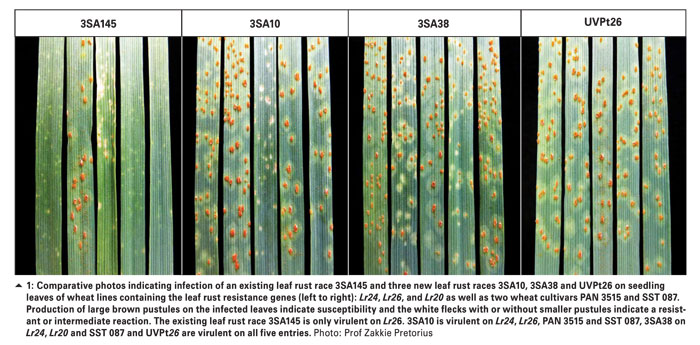
Scientists at UFS are currently busy with DNA marker work to determine whether the new races can indeed be grouped with 3SA145. Subsequent seedling screening of commercial wheat cultivars and advanced breeding lines from all three breeding programmes in South Africa, have confirmed that UVPt26 is the most threatening of the new leaf rust races, especially when compared to 3SA145.
Spring wheat entries were more affected by the new races with 10% of entries found susceptible to UVPt26 as compared to 3SA145. Field evaluation of commercial cultivars and advanced breeding lines will be performed in the coming season and the leaf rust rating of cultivars affected, based on their adult plant field reaction, will be adjusted for inclusion in the 2018 production guidelines of ARC-Small Grain. In the meantime, wheat producers need to monitor the rust situation in their wheat fields during 2017 and the following seasons as the new leaf rust races could result in increased rust infection on susceptible cultivars.
Observation of susceptibility on a previously resistant cultivar is an indication that the new races have probably caused the infection and that the specific cultivar has lost its leaf rust resistance.
In this case, timeous fungicide application may be required to prevent possible further outbreaks and consequent economic loss. Races 3SA10, 3SA38 and UVPt26 bring the number of new leaf rust races identified over the past seven years to seven, indicating continued variability of rusts in South Africa and stressing the need for regular rust monitoring to timeously identify and control new races. There were no new stem rust or stripe rust races detected in 2016. Therefore, previously known resistant genes and cultivars are expected to remain effective against the existing races of the two rusts.
Publication: September 2017
Section: Focus on



